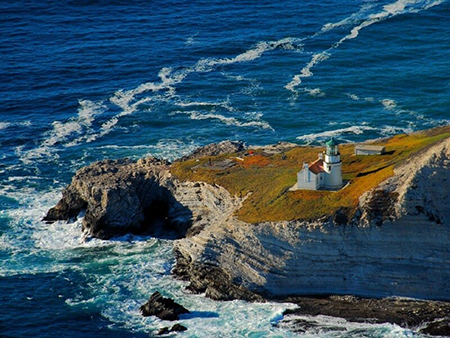Point Conception is a headland along the coast of southwestern Santa Barbara County. It is the point on the coast where the warmer waters of the Santa Barbara Channel meet the Pacific Ocean, and it is also a place where strong currents converge, causing dangerous turbulence in a rocky area. Because of the dangerous weather, wind, and water conditions, which resulted in hundreds of shipwrecks, it was determined in 1852 that a lighthouse was necessary. In 1855, the schooner General Pierce brought a First Order Fresnel Lens to the new lighthouse, and thus delivered one of the major scientific and technological advancements of the 19th century.
Invented by French Physicist Augustin-Jean Fresnel, and built in Paris in 1854, the lens uses 624 glass prisms, which was cutting edge technology for its day. The 18-foot tall lens weighs nearly 6,000 pounds. While it was operational, the lens projected a beam 25 miles into the most perilous waters off the California coast.

View a Time Lapse Video of the Lens Installation
In 2012, the United States Coast Guard approached SBMM about submitting a proposal to transfer the lens from the lighthouse to the museum. The project was risky, as Point Conception Lighthouse is located on a remote bluff-top 50 miles from Santa Barbara, with no road access. SBMM was able to work with a U.S. Coast Guard-designated lampist, a person allowed to transfer a lens such as this one, on the logistics of disassembling, packaging, and moving the lens first via helicopter and then by trucking transport to its final home at the museum. Today, SBMM cares for and displays the lens, which many believe is the most important maritime artifact along the Santa Barbara Channel.
